
Today, and for some time, statues have been leading dangerous lives. They have been hanged, toppled, drowned and defaced. Even the great statue of Captain James Cook in Sydney’s Hyde Park has been twice vandalised with painted slogans. Like the man whose acts it honours, the statue does not run away. It asks us to to tell the truth about the man and the values he embodied.
At eighteen Cook began his life at sea, sailing coal ships out of Whitby to London, into the North Sea, the Baltic and the Irish Sea. In 1755 he joined the Navy, fought the French at Quebec and showed his talent by charting the St Lawrence River, and later the cost of Newfoundland. In 1768 he was given command of the first of three great voyages. Until his death 1779 he spent eight and a half years at sea, with little time for his family. He endured hardship and illness and was killed on duty. He charted New Zealand, the east coast of Australia, and explored much of the vast Pacific Ocean.In his own lifetime James Cook became a hero, a word inherited from Latin and ancient Greek, meaning a demigod, a person of exceptional strength and courage who protects us from danger. Cook protected his sailors and scientists from the fu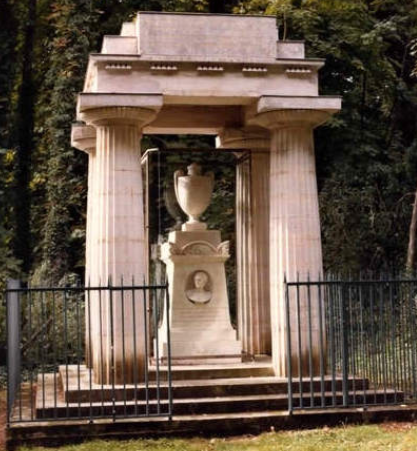 ry of the sea, from scurvy, hunger and thirst and from getting lost in uncharted waters. His maps and charts would protect ships that followed after him through difficult passages and past hazardous rocks and reefs.
ry of the sea, from scurvy, hunger and thirst and from getting lost in uncharted waters. His maps and charts would protect ships that followed after him through difficult passages and past hazardous rocks and reefs.
Nine years after Cook’s death, a French nobleman, the Marquis Jean-Joseph de Laborde, had a cenotaph (right) erected to Cook’s memory in the garden of his country chateau, about 70 kilometres south of Paris. Laborde took a great interest in navigation and discoveries. Indeed, two of his sons had drowned in a bay on the Alaskan coast in 1786, while serving in La Pérouse’s ill-fated expedition into the Pacific. Laborde paid one of the best-known sculptors of the day, Augustin Pajou, to make a portrait bust of Cook for the cenotaph, and a fine copy is now owned by the National Museum of Australia which notes:
C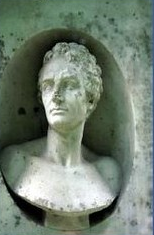 aptain James Cook was not only a hero in Britain — his fame spread throughout Europe, as readers devoured accounts of his voyages translated into many languages. The veneration of Cook transcended even France and Britain’s fierce imperial rivalry.
aptain James Cook was not only a hero in Britain — his fame spread throughout Europe, as readers devoured accounts of his voyages translated into many languages. The veneration of Cook transcended even France and Britain’s fierce imperial rivalry.
The bust (left) is an idealised portrait, resembling a person from classical antiquity, signifying that Cook was fit company for the founders of Western civilisation.
Another sculptor, Thomas Woolner, was to create the Hyde Park statue of Cook. Woolner knew Australia. In 1852, aged 27, he decided to try his luck on the goldfields. Though he was already making a name for himself in London among the pre-Raphaelite artists, whose ideals of truth to nature, high seriousness and poetic spirit appealed to him, sculpture was an expensive medium to work in and not so easy to sell. A friend who farewelled him, Ford Madox Brown, in some sadness it seems, was inspired to paint a now famous picture, The Last of England.
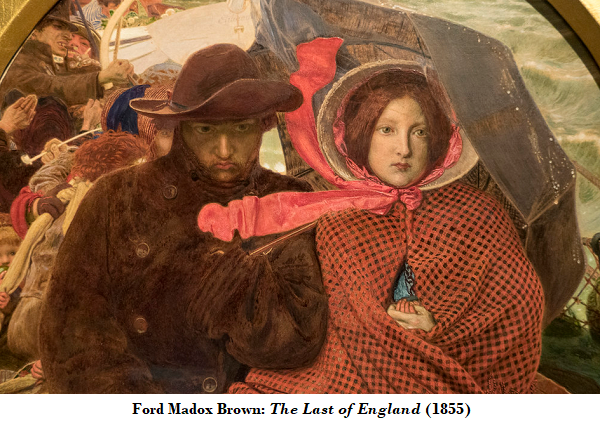
For his part, Woolner delighted in his Australian journey:
When I first saw Australia its hills were soaked in romantic richness, and a halo of promise crowned it with glory. Although I was so unsuccessful.., I do not regret going to the gold-fields. It has made me strong and more vigorous than I ever felt before.
He began making portrait medallions of prominent citizens, first in Melbourne and later in Sydney, where he spent six months and enjoyed ‘the beauties of its matchless harbour’. In 1854 he returned to London, and over the next 25 years became one of England’s most eminent sculptors and a member of the Royal Academy.
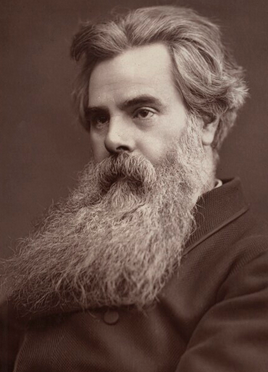 Sculptures of people, like portraits, bring us into a personal relationship, disclosing characteristics, qualities or values that we might wish we had ourselves. We have already seen how Pajou’s image of Cook, so different from any other, presents Cook as a classical hero. Thomas Woolner’s sculpture presents a more familiar likeness, but draws us into the meaning of his subject’s life. Woolner (left) wrote:
Sculptures of people, like portraits, bring us into a personal relationship, disclosing characteristics, qualities or values that we might wish we had ourselves. We have already seen how Pajou’s image of Cook, so different from any other, presents Cook as a classical hero. Thomas Woolner’s sculpture presents a more familiar likeness, but draws us into the meaning of his subject’s life. Woolner (left) wrote:
…the expression of persons whose minds are fixed on high and holy things grows better every instant of their lives, thro’ growing in fact nearer to that perfection they contemplate .
In 1874, the NSW government approached him to create a great statue of Captain Cook in bronze for a site with a commanding view of the harbour. When Woolner designed and modelled Cook, he wanted to involve us in the character of a great navigator who explored the Pacific Ocean and revealed the coastline of its continents, islands and reefs.
My idea is…to make an animated figure filled with wonder and delight, in the moment of discovering a new country; smitten by the sun, he would always stand a shining welcome to all comers to the fair Australian land.
In 1878, the finished work was shown briefly in London where The Art Journal said:
It is unquestionably a work designed with a force and spirit that raise it to the character of sensational.
It was no surprise that when the statue arrived in Sydney, people tried to get a glimpse of it as it was unloaded from the ship, but little could be seen. They had to wait for the official unveiling.
Tuesday, February 25, 1879, was declared a public holiday, and a crowd of about 70,000 people saw the Governor of NSW, the Rt Hon. Sir Hercules Robinson GCMG, unveil the colossal bronze statue. Bronze, an alloy of copper and tin, can withstand the weather and the test of time. It is a hard, durable material but demands great skill to cast, especially in such a complex form. Captain Cook stands nearly four metres tall on a pedestal about seven metres high, probably the highest statue in the city of Sydney, and certainly the largest Woolner ever designed and modelled . Cook’s colossal statue marked his great importance to Australia.
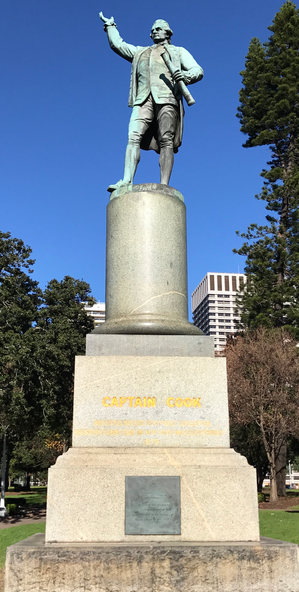 Cook looks out over Woolloomooloo Bay to see all the vessels coming into dock. His face shows seriousness and resolution:
Cook looks out over Woolloomooloo Bay to see all the vessels coming into dock. His face shows seriousness and resolution:
The fine head is most expressive and characteristic of the keen observer and dauntless discoverer, in the massive brow with deep furrows at the temple and strongly moulded nose and chin.
The dress, which is the well-known naval uniform of the day, with the open-breasted broad tailed coat, the long flap waistcoat, and the knee-breeches, with shoes, is remarkable for good work, falling to the figure naturally and not ungracefully, the gold lace being to some extent represented by a lighter-coloured bronze. But all these points of detail are quite unobtrusive, and subservient completely to the noble air of brave sell-confidence expressed in the intellectual countenance, the broad and vigorous frame, and the general action of the figure.
In his left hand he holds a telescope, folded up, a reminder of his skill as a navigator and symbol of extended vision, far beyond the capacity of the unaided human eye. His right arm, stretched out above his head, the palm facing up to the sky seems to be showing us that his nineteen day journey westwards from New Zealand has now come to fruition. He discovered and named the territory of New South Wales, by which he meant the whole east coast of Australia, made known to the world as a single entity, no longer only as separate ranges of indigenous peoples.
Recently, critic and scholar Caroline Clemente observed:
Despite differing views as to the artistic merits of the Cook statue, this monumental figure does, in fact, splendidly embody the ideals of … truth to nature, high seriousness and poetic spirit. Cook is presented as the heroic explorer: his stern, farseeing gaze and commanding stance, articulated by the details of his handsome costume and the monumental dimensions of his figure, signify the weight of his impact on Australian history. Towering over Sydney’s Hyde Park, this is Woolner’s final contribution to this sunny land of promise so cherished in his memory.
The sculptor shows a human form, but invites us to grow greater and taller through exceptional human achievement and the search for higher virtues. The artist transformed inorganic matter, taken out of the ground, into a lasting inspiration.
See also: Too Many Cooks Boil the Wroth
TODAY, the lives of those commemorated in public statues, especially if they are white and male, face reckless accusers, burning to uncover sins more wicked than their own. Captain Cook frustrates their desires. He never enjoyed a privileged background and largely educated himself while on duty in the navy. On the Endeavour voyage he was substantively just a lieutenant, commander of his vessel but not yet a gazetted captain, and never became rich or was ennobled. He made remarkably few mistakes, despite all the dangers of sailing so far from home in unknown waters. Perhaps his worst error was inattention on the moonlit night when the Endeavour struck a coral reef, and might have foundered, costing everyone their lives. Concerning his own role in discovering Australia, he said only that he believed he was ‘the first European’ to explore its eastern coastline.
Against Cook, his accusers invoke a law of suspects who must prove their innocence or suffer punishment, not only for their own conduct or words, but those of their relations. The guilt of the children disgraces the parents and the guilt of the parents disgraces the children. In his journal entry for August 22, 1770, Cook wrote: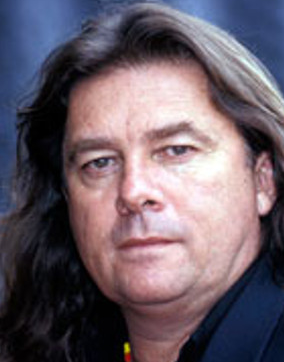
I now once more hoisted English colours and in the name of His Majesty King George the Third took possession of the whole eastern coast …by the name of New South Wales together with all the bays, harbours, rivers and islands situate upon the said coast.
This claim of possession, according to Professor John Maynard (left), who identifies as an Aboriginal historian, was Cook’s offence:
In raising the British flag on Possession Island in the Torres Strait, Cook unleashed cataclysmic consequences upon Aboriginal people of the Australian continent… In the wake of this single event, … horrific impact and cultural destruction … would explode across the continent in the decades ahead.
Cook’s small ceremony on a remote island near Cape York — if, indeed, it took place at all — had no effect until it could become public on his return to London. From there, it was made known to Europe and America, but was important only to those with an interest in the Pacific, most notably the Netherlands and France. As a naval officer, Cook had fought the French in Canada, and would not have wanted New South Wales to fall into French hands. As it happened, unbeknown to Cook, a French ship sailed past Sydney Heads on December 4, 1769, five months before him, but its crew never spotted the land. His claim simply gave notice to other nations that England would oppose rival claims to eastern Australia.
For the indigenous peoples of Australia, Cook’s claim was unknown and irrelevant. Cook himself unleashed no consequences upon them because he was killed by indigenous inhabitants of Hawaii in 1779, well before the British government did anything about its claim to New South Wales. Maynard adds a further charge that Cook disobeyed his instructions by claiming possession without the consent of the inhabitants. In fact, the instructions mention the need for consent only in connection with the ‘great southern continent’. They go on to permit claims of possession elsewhere, without mentioning the inhabitants’ consent . Eastern Australia was already known as New Holland, and nobody thought it was the undiscovered great south land.
The cataclysmic consequences after Cook’s death cannot be attributed to him but only to those who wrought them. Some were unforeseen and unintended, for example the wave of deaths from European diseases. The later exclusion of Aboriginal people from hunting and food gathering on traditional lands was deliberate, and the consequential killings, cruelties and indifference stained our historical record. Yet from the beginning, some Aboriginal people chose to live in the new settlements. When food in the bush ran short, some went up the Governor Phillip’s domain to get rations. A leader, Bennelong, travelled back to England with Phillip to see what England was like. Many indigenous people made homes in colonial Sydney town , and most indigenous people live in urban Australia today.
Finally, with British settlement in 1788, Cook became the founder, and symbolically a father, of modern Australia and of all the settlers who came from overseas and made their homes here from 1788 to the present day. Through the countless mixed relationships between Aboriginal people and new settlers, Cook also became a symbolic grandfather of the majority of indigenous Australians who now carry ‘mixed blood’ from the new settlers. Through the institutions of law and government all citizens of whatever colour or bloodline share the one country, the nation Cook inaugurated.
We have no need to revise the Governor Robinson’s judgement when he unveiled Cook’s statue in Hyde Park: James Cook left behind ‘a noble and imperishable memory’ . The statue is our reminder, a work of art that invites us to live up to his example of care for those under him, courage in danger and joy in discovery. Cook salutes a country full of promise. He welcomes anyone who looks at him, whatever their origins. The statue embodies an extraordinary story, which we need to retell and need never erase.
Michael Dunn is retired and lives in Sydney
References:
Thomas Woolner, see Amy Woolner, Thomas Woolner, R.A., sculptor and poet, his life in letters, New York, 1917, p.297 at https://archive.org/details/thomaswoolnerras00wooluoft/
Sydney Morning Herald commentary on the statue and Sir Hercules Robinson’s opening address 25 and 26 February 1879
Contemporary commentary on the statue by Caroline Clemente, ‘Thomas Woolner: a Pre-Raphaelite Sculptor in Australia’, Australasian Journal of Victorian Studies, Vol 22, No 2, 2018
Law of suspects: A decree passed during the French Revolution in 1793, under which the Marquis de Laborde was guillotined, and whose provisions frequently copied under various dictatorships.
Cook’s claim to NSW: James Cook, Journal of Remarkable Occurrences aboard His Majesty’s Bark Endeavour, 1768-1771, entry for 22 August 1770, at http://southseas.nla.gov.au/journals/cook/17700822.html
John Maynard, ’I’m Captain Cooked’: Aboriginal perspectives on James Cook, 1770–2020’, Digital classroom, National Library of Australia, Canberra, 2020 at https://www.nla.gov.au/digital-classroom/senior/Cook/Indigenous-Response/Maynard
French ship near Sydney Heads: The St Jean-Baptiste under Capt.de Surville, see G. Blainey, Captain Cook’s Epic Voyage, Melbourne, 2020, pp. 88-96
Cook’s instructions: Secret instructions from the the Lords of the Admiralty to Lt James Cook, 30 July 1768, https://www.nla.gov.au/content/secret
Aboriginal people in colonial Sydney: Grace Karskens, The Colony: a History of Early Sydney, Sydney, 2009, especially chapter 12
 Sign In
Sign In 0 Items (
0 Items ( Search
Search









Thank you Michael. Great piece. Being over seventy years old, it had never occurred to me – until the latest spate of ‘protests’ – that Cook’s statue, let alone his reputation, might need to be defended. Possibly that sort of complacency, multiplied many times over, is the cause of the current troubles. I always enjoy visiting the fine Webber portrait in the National Portrait Gallery.
Captain James Cook – my sort of guy!
An amazing life, an extraordinary vision and great humanism.
I’ve always thought that aboriginal (and Maori) antagonism to Cook has nothing to do with Cook’s own actions, and everything to do with much later school classes citing Cook’s landing as the origins of Australia (which it was of course). So all the resentments of aboriginal people were, by default, piled onto Cook. Part of it is copy cat of the campaigns against Columbus in the US, but Columbus did enslave the inhabitants of Hispaniola when he was Governor and was accused by his enemies of brutality (pretty bad even by the standards of the time – but it was a slander by those resentful of his position). Cook surveyed Botany Bay, and stayed in Cooktown for a few weeks to enable the crew to repair the Endeavour. Apart from taking possession, and a remarkably few clashes with local aboriginals, that’s it!
In truth, aboriginal and Maori campaigns against Cook are really proxy attacks on non-aboriginal people and society. Those lefties joining in aren’t interested in Cook and his actions. Either they’re imagining they’re absolved from their own “guilt” by denigrating the man, or else they’re seeking to delegitimise our country by smashing the “founder” with the arrogant fantasy they can they have a blank sheet to paint their ideal society on! Note this latter view only uses aboriginal people as a justification, and has no real concern with them or their identity.
An excellent piece. Much appreciated by me and others.
Thank you, Michael, for an admirable piece of research. As a Woolner scholar myself I view any attempts to move (and indeed daub) the statue with great concern. At the moment some well intended but wrong-headed curators and academics are attempting to move the statue to a museum and I was asked to sign their open letter. I refused because it would be a nonsense – the monument was sculpted the way it is to be seen elevated on its magnificent site – and how could you hope to replicate this in the limited space of a museum?
Unfortunately the people behind the campaign, with few exceptions, have little knowledge, still less love, of our Victorian heritage. Politically, I would imagine they would subscribe to the leftist nostrum that the Enlightenment was a racist project – which forestalls any constructive debate I nonetheless made two friendly appeals to the two main organisers, requesting dialogue. Silence. I’ll leave with a thoughtful quotation on Cook by the New Zealand writer/reviewer Graeme Lay: ‘The real culprits in our colonisation story were not Cook and his crews but the hordes of men who came in his wake: the whalers, sealers, traders, land speculators and gun-runners who saw New Zealand mainly as a place ripe for plundering.’
“One of the most remarkable voyagers in the long history of the seas, he [Cook] deserves far more praise than blame. Contrary to the common belief, he admired the Aborigines and facets of their traditional way of life. Above all he grasped this continent and began unknowingly the work of knitting it again to the outside world. On the whole the outside world has gained because of his epic voyage. The settlers who arrived after him eventually made this land so productive that it is capable, almost annually, of feeding tens of millions of people in foreign lands as well as all those in Australia. Here flourishes a democratic society which offers freedom in a world where freedom is not — and never was — the right of most people.” – Geoffrey Blainey, ‘Captain Cook’s Epic Voyage’